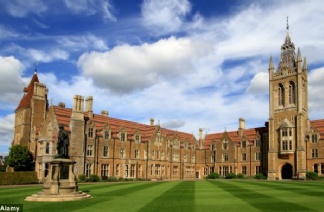下面就是今天
5月7日SAT考试写作部分比较难。Essay部分的阅读文章选自2009年发表在Vanity Fair上的由Christopher Hitchens写的一片社论文章,讲的是希腊古雕塑本身艺术价值极高,历史上被破坏和贱卖给英国,作者主张应该还给希腊。这次的 “The Lovely Stones” 和官方给出的大部分文章一样, 遵循一个模式:呈现一个问题+分析问题背景+呼吁行为。
难度高于OG的文章和2016年3月北美的文章,主要是因为涉及较多历史、雕塑等专业词汇,许多考生可能阅读要花较多时间阅读且理解难度大。
以下是本次考试写作阅读原文:
The great classicist A. W. Lawrence (illegitimate younger brother of the even more famously illegitimate T.E. “of Arabia”) once remarked of the Parthenon that it is “the one building in the world which may be assessed as absolutely right.” I was considering this thought the other day as I stood on top of the temple, and watched the workshop that lay below and around me. Putting the rightest, or most right, building to rights means that the workers must use marble from a quarry in the same mountain as the original one, that they must employ old-fashioned chisels to carve, along with traditional brushes and twigs, and that they must study and replicate the ancient Lego-like marble joints with which the master builders of antiquity made it all fit miraculously together.
The damage done by the ages to the building, and by past empires and occupations, cannot all be put right. But there is one desecration and dilapidation that can at least be partially undone. Early in the 19th century, Britain’s ambassador to the Ottoman Empire, Lord Elgin, sent a wrecking crew to the Turkish-occupied territory of Greece, where it sawed off approximately half of the adornment of the Parthenon and carried it away. As with all things Greek, there were three elements to this, the most lavish and beautiful sculptural treasury in human history. Under the direction of the artistic genius Phidias, the temple had two massive pediments decorated with the figures of Pallas Athena, Poseidon, and the gods of the sun and the moon. It then had a series of 92 high-relief panels, or metopes. The most intricate element was the frieze, carved in bas-relief, which showed the gods, humans, and animals that made up the annual Pan-Athens procession: there were 192 equestrian warriors and auxiliaries featured, which happens to be the exact number of the city’s heroes who fell at the Battle of Marathon.
Ever since Lord Byron wrote his excoriating attacks on Elgin’s colonial looting, first in Childe Harold’s Pilgrimage (1812) and then in The Curse of Minerva (1815), there has been a bitter argument about the legitimacy of the British Museum’s deal. I’ve written a whole book about this controversy and would just make this one point. If the Mona Lisa had been sawed in two during the Napoleonic Wars and the separated halves had been acquired by different museums in, say, St. Petersburg and Lisbon, would there not be a general wish to see what they might look like if re-united? If you think my analogy is overdrawn, consider this: the body of the goddess Iris is at present in London, while her head is in Athens. The front part of the torso of Poseidon is in London, and the rear part is in Athens. And so on. This is grotesque.
It is unfortunately true that the city allowed itself to become very dirty and polluted in the 20th century, and as a result the remaining sculptures and statues on the Parthenon were nastily eroded by “acid rain.” And it’s also true that the museum built on the Acropolis in the 19th century, a trifling place of a mere 1,450 square meters, was pathetically unsuited to the task of housing or displaying the work of Phidias. But gradually and now impressively, the Greeks have been living up to their responsibilities. Beginning in 1992, the endangered marbles were removed from the temple, given careful cleaning with ultraviolet and infra-red lasers, and placed in a climate-controlled interior. Alas, they can never all be repositioned on the Parthenon itself, because, though the atmospheric pollution is now better controlled, Lord Elgin’s goons succeeded in smashing many of the entablatures that held the sculptures in place. That leaves us with the next-best thing, which turns out to be rather better than one had hoped.
About a thousand feet southeast of the temple, the astonishing new Acropolis Museum will open on June 20. With 10 times the space of the old repository, it will be able to display all the marvels that go with the temples on top of the hill. Most important, it will be able to show, for the first time in centuries, how the Parthenon sculptures looked to the citizens of old.
The Acropolis Museum has hit on the happy idea of exhibiting, for as long as following that precedent is too much to hope for, its own original sculptures with the London-held pieces represented by beautifully copied casts. This has two effects: It allows the visitor to follow the frieze round the four walls of a core “cella” and see the sculpted tale unfold (there, you suddenly notice, is the “lowing heifer” from Keats’s Ode on a Grecian Urn). And it creates a natural thirst to see the actual re-assembly completed. So, far from emptying or weakening a museum, this controversy has instead created another one, which is destined to be among Europe’s finest galleries. And one day, surely, there will be an agreement to do the right thing by the world’s most “right” structure.
文章和写作思路分析:
1、文章分析
文章主题是英国应该归还属于希腊的几件雕塑作品。
P1:通过A. W. Lawrence的话引出本文主角 the Parthenon希腊的帕台农神殿。
P2:细数 帕台农神殿的悲催历史,如曾被关闭,无人问津,之后被改建为基督教教堂,又被土耳其军队用作工事,被炸弹严重损毁,,总之一路被虐。其实原文第三段首句就是对本段最好的总结:The damage done by the ages to the building。
P3:回忆完历史后,作者在本段亮出观点: But there is one desecration and dilapidation that can at least be partially undone. 往事虽已成舟,但有一件劣迹尚可挽回,即英国在19世纪暴力锯下并掠夺了神殿里将近一半的装饰性雕塑作品,如今应该物归原主,其中艺术价值最高的三块浮雕是包括两大块山型墙饰(pediments)和一条雕带(freize)。段末强调了一下这条雕带上的浮雕讲述了一个连贯的故事( a continuous narrative)且有一半被卖到了英国伦敦,暗示了完璧归赵的必要性。
P4:作者用了一系列类比来论证上段中那笔交易不合理,一是《蒙娜丽莎》被锯成两半然后被不同博物馆瓜分,二是希腊神话里的彩虹女神身首异处,等等,段末给出结论This is grotesque.
P5:开始让步,承认希腊确实曾经自甘堕落,任其雕塑被雨打风吹去。然后反驳,说希腊人已经开始承担责任去保护那些艺术作品,并用了一个事实支持。 Beginning in 1992, the endangered marbles were removed from the temple, given careful cleaning with ultraviolet and infra-red lasers, and placed in a climate-controlled interior.
P6:继续摆出更多事实支持上段主题,如神殿附近会新开一家博物馆Acropolis Museum,旨在展示神殿的雕塑。
P7 :说英国可以继续死撑着不还,但是Acropolis Museum已经打算办一个展览,展出自己收藏的一半真迹,被英国抢走的一半则用仿品代替,这样参观者自然就会渴望看到完整的真迹,试图通过人民群众向英国施压。最后结尾说终有一日可以合璧。
2、写作思路分析
本文写作角度可以有以下这些:
word choice/appeal to emotion:P2里在描述神殿悲惨历史时作者用到了一些比较重的词,如tragic result , huge damage ,Most horrible of all, 以此来唤起读者恻隐之心,为之后段落打好感情基础。
reasoning:P3里对那条雕带(freize)描述时强调了一下这条雕带上的浮雕讲述了一个连贯的故事( a continuous narrative)且有一半被卖到了英国伦敦。可以理解为作者从理性的角度跟读者讲道理,你看只有一半连故事在讲什么都不知道,多没意思。
irony:P3最后说那条雕带当时是被人贱卖还债的 having been sold well below cost by Elgin to the British government in 1816 for $2.2 million in today’s currency to pay off his many debts.相当荒诞的一个桥段,依然论证交易的不合理。
analogy(stylistic elements):P4中的一系列类比,如《蒙娜丽莎》被锯成两半然后被不同博物馆瓜分,如希腊神话里的彩虹女神身首异处,等等,通过荒诞的假设论证帕台农神殿雕塑被卖给英国的不合理性。
concession and rebuttal(stylistic elements):P5和6,先让步,承认希腊确实曾经没把那些雕塑当回事。然后反驳,用了一系列事实说希腊人已经开始觉醒并承担责任去保护那些艺术作品。
evidence:上面提到的P5-6里的一系列事实。
本次考试阅读文章的难点主要就是在阅读上,文章中有较多的专业词汇如果考生对这些词汇看不懂的话那么阅读起来比较困难。读懂之后文章的思路会比较清晰,写作手法典型且丰富。这次的写作考试反映出来在平时的阅读量的重要性,这也是大家备考的主要方向。
相关推荐:

















